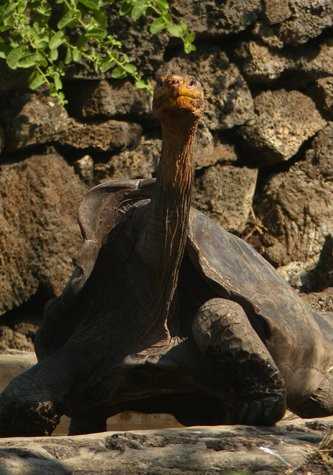The sun rose in a practically clear sky this morning; a sunny, hot day was in store for us. Today was tortoise day. Although we had gotten a glimpse of two wild tortoises a couple of days ago in Urbina Bay, western Isabela Island, today we focused on the differences between species sizes and shapes, and more important, the “why” of these differences.
Housed in the Tortoise Rearing Center right now are several giant tortoises recently brought in from Wolf Volcano, on Isabela Island. Through genetic studies, it was realized there was a very good explanation for why this one volcano, out of Isabela’s five volcanoes, had both domed and saddleback tortoises living on its northwestern flank; they were originally from different islands. So far, these individuals are all hybrids, so it is their parents or grandparents who were originally from other islands. One ship’s log, written by Captain David Porter in 1812, made mention of giving chase to British whaling vessels in the area known as Banks Bay at the foot of Wolf Volcano. In attempts to pick up speed for escape, they jettisoned their food supply (giant tortoises) overboard. Some of these most likely drifted ashore and made the volcano their new home, breeding with the local population of tortoises in the subsequent years.
Fortunately for us they did, because some populations of tortoises later became extinct on their home islands, such as Lonesome George from Pinta Island, and the species from Floreana Island in the southeast of the archipelago that went extinct around the 1850s. These hybrids are now in the breeding center and are playing an immensely important role in re-establishing their native populations. It might take a while, but they already have a good start!
The afternoon allowed us to continue our focus on giant tortoises, but this time exclusively on the largest native population for Santa Cruz Island, Chelanoides porteri. This is a massive domed species, one of three distinct tortoise species found on this one island. Rather unusual, this discovery is only a few years old and once again due to the investigation of origins using DNA analysis. The other two species of giant tortoises on Santa Cruz Island are much more scarce and not easily found in the wild; one to the east and the other to the northwest.
The afternoon was filled with giant tortoise sightings. From the bus, before we even got to our destination, giant tortoises were spotted in the fields and even in the road! I can’t imagine how many hundreds of photographs were taken of this iconic animal of the Galapagos Islands. Most were quietly sitting out the heat of the sunny day in the shade and shadows of the trees and shrubs. A few were sunk deeply up to their eyebrows (if tortoises had eyebrows) in mud or fern-filled ponds. There was plenty of time to admire these solid, deep-time personalities who looked back at us through dark, shiny eyes. We can never know what goes through their minds when they watch us…these quick, noisy animals who stare at them while making numerous clicking sounds and before running away again, just as quickly.
So many people and organizations here in the islands are making it their life’s work to make sure these creatures and their ecosystems will thrive and continue for a long time into the future. After all, they’ve been here for millions of years, adapting, changing. We have no right to appear suddenly, and then in just a few hundred years do irreparable harm to them and their land. It is satisfying and enriching to know we have given our guests a chance to experience this preserved essence of the islands. With this understanding, our hope is our guests will remember how unique this place is, and the immense good we humans can bring as well.









